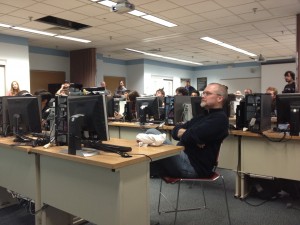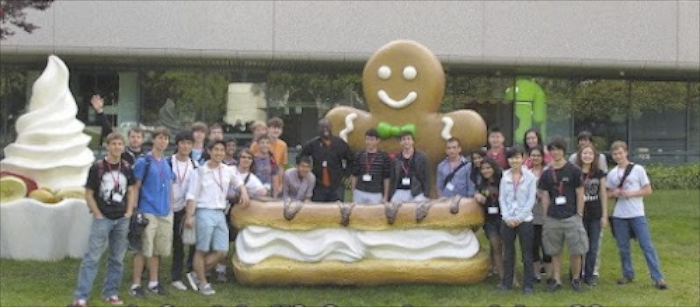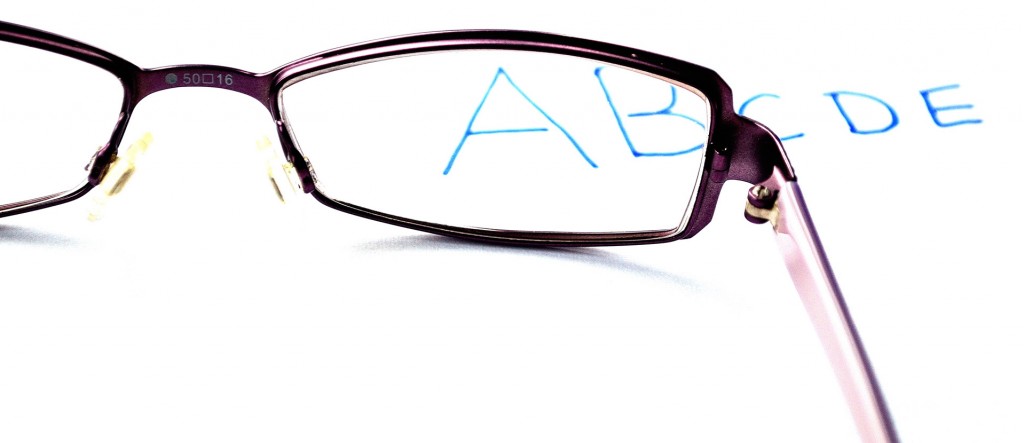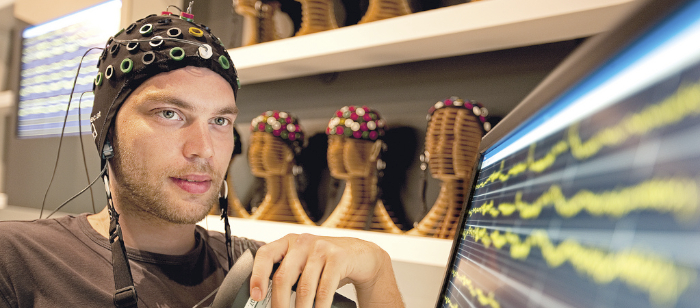 Game enthusiasts of all stripes hunkered behind computer screens in the UMBC GAIM Lab for the 4th annual Global Game Jam—a fast-paced weekend where teams around the world conceive and creative video games around a common theme. The three-day event, which took place Friday, January 27th through the 29th, drew nearly forty participants ranging from undergraduate and graduate students, alumni, and even current game developers.
Game enthusiasts of all stripes hunkered behind computer screens in the UMBC GAIM Lab for the 4th annual Global Game Jam—a fast-paced weekend where teams around the world conceive and creative video games around a common theme. The three-day event, which took place Friday, January 27th through the 29th, drew nearly forty participants ranging from undergraduate and graduate students, alumni, and even current game developers.
Dr. Marc Olano, professor of Computer Science and Electrical Engineering and Neal McDonald, assistant professor of Animation & Interactive Media, have been running the jam at the UMBC site since its inception four years ago. “It’s intense but I think people have a lot of fun,” says Olano, who is also the director of the Computer Science Program’s Game Development Track.
The weekend follows a strict itinerary. At 5 p.m. on Friday, a video keynote kicks off the competition and the secret theme is announced. From that point on, participants have until 3 p.m. on Sunday to complete a game from start to finish. Factor in eating and sleeping, and it’s not much time. “Three days is an extremely short period of time,” says Olano. “In terms of wall-clock time,” he says, “it’s a little less than two days.”
In previous years, themes included “As long as we’re together, there will always be problems,” or more simply, “extinction.” But this year, a theme was chosen that could be equally relatable to the nearly 11,000 participants from countries like Canada, Sweden, Brazil, France, Italy, Hungry, Israel, and Japan (to name a few). Instead of a phrase, this year’s theme was apicture: Ouroboros–a snake eating its own tail–which Wikipedia describes as a representation of “the perpetual cyclic renewal of life.”
Some teams were inspired by this idea of reincarnation, including the team responsible for Bit Exhaust, a game developed for the Microsoft Windows Phone platform. Reminiscent of Space Invaders, though graphically and conceptually more sophisticated, Bit Exhaust turns conquered foes into allies and visa versa. “What we took from the theme was rebirth and cyclic life,” reads the game description on the Game Jam Website. “Enemies and allies are constantly switching sides as you kill them and they die.”
Bit Exhaust was the recipient of an award from Next Century Corporation, whose sponsorship allowed the Global Game Jam to be a free (and catered) event for all participants.
 Even Microsoft sweetened the deal with the promise of a free phone for teams who chose to develop games for their windows phone platform (not surprisingly, six of the ten teams opted to do just that). In addition, Microsoft offered up two prizes to phone-based games: second place to Bit Exhaust, and first place to Survive the Serpent, a literal take on the event’s theme. The 2-D maze game features a character who must escape being eaten by a snake by outsmarting it into biting its own tail.
Even Microsoft sweetened the deal with the promise of a free phone for teams who chose to develop games for their windows phone platform (not surprisingly, six of the ten teams opted to do just that). In addition, Microsoft offered up two prizes to phone-based games: second place to Bit Exhaust, and first place to Survive the Serpent, a literal take on the event’s theme. The 2-D maze game features a character who must escape being eaten by a snake by outsmarting it into biting its own tail.
Each year the People’s Choice Award is given to the game that’s voted the best overall by its peers. This year the winner was Snake ‘N Bake, a two-player game where a snake must help a cupcake make it to the oven before the tasty confection gets hit by a fireball.
Though individual sites—like UMBC—can offer prizes, Olano stresses that the Global Game Jam is not a competition. “They really want it to be more about cooperation than about competitiveness,” he says of the event’s sponsor, the International Development Association (IGDA). It’s not uncommon, he says, for teams to help each other out during the three-day fest.
Olano says he is definitely planning to host the Global Game Jam again next year, which will again put UMBC among other local hosts including Shady Grove, American University, and George Mason University. The Global Game Jam is the largest gam jam event in the world, according to its website. “This year there were 246 locations around the world,” says Olano, and the number will only grow.










